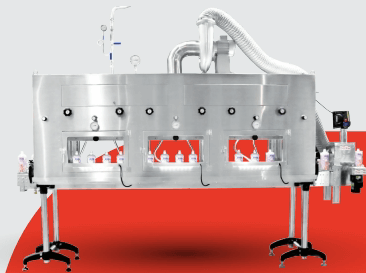
Shrink sleeve labels are a popular packaging solution that provides various benefits for product manufacturers. These labels are made from a flexible material that can be shrunk to fit tightly around the contour of a bottle or container. The shrink sleeve label offers 360-degree coverage, allowing for maximum design space and eye-catching graphics. This type of labeling is commonly used in industries such as food and beverage, cosmetics, and household products.
One of the main benefits of shrink sleeve labels is their ability to provide tamper-evidence. Once the label is shrunk onto the bottle, it cannot be removed without leaving visible signs of tampering. This is crucial for ensuring the safety and integrity of the product. Additionally, shrink sleeve labels are highly durable and resistant to moisture, making them ideal for products that require refrigeration or exposure to water.
Another advantage of shrink sleeve labels is their versatility. They can be applied to bottles of various shapes and sizes, including those with complex contours or irregular surfaces. This makes them a popular choice for products with unique packaging designs. Shrink sleeve labels also offer a high level of customization, allowing for vibrant colors, intricate designs, and even special effects such as holographic or metallic finishes.
In summary, shrink sleeve labels provide numerous benefits for product manufacturers, including tamper-evidence, durability, versatility, and customization. By understanding the advantages of shrink sleeve labels, manufacturers can make informed decisions about their packaging solutions and achieve perfect bottle body label shrinkage.
Steam tunnels play a crucial role in the shrink sleeve labeling process. These tunnels use steam to shrink the sleeve label onto the bottle, creating a tight and seamless fit. The steam activates the heat-sensitive label material, causing it to shrink and conform to the shape of the container.
One of the key advantages of using steam tunnels is the ability to achieve consistent and uniform shrinkage across multiple bottles. The steam heat ensures that the label shrinks evenly without any wrinkles or creases, resulting in a professional and aesthetically pleasing appearance. Steam tunnels also provide a fast and efficient sleeve labeling process, allowing for high production rates.
When using a steam tunnel, it is important to adjust the temperature and steam pressure according to the specific requirements of the shrink sleeve label material. Different materials may have different heat sensitivity, so it is essential to follow the manufacturer's guidelines for optimal shrinkage. Additionally, proper positioning of the steam nozzle is crucial to ensure that the steam is evenly distributed across the entire label surface.
In conclusion, steam tunnels are essential equipment in the shrink sleeve labeling process. They enable consistent and uniform shrinkage, fast production rates, and precise control over temperature and steam pressure. By utilizing steam tunnels effectively, manufacturers can achieve perfect bottle label shrinkage.
The steam tunnel as below, there are shrink section and cooled steam exhaust section. Shrink section is bottle and steam mixed together; cooled steam exhaust section is to vent cooled steam. In order to ensure that the subsequent high-temperature steam can continue continue to fill the tunnel shrink section , cooled steam exhaust vents are installed on both sides of the tunnel body to extract the cooled steam.
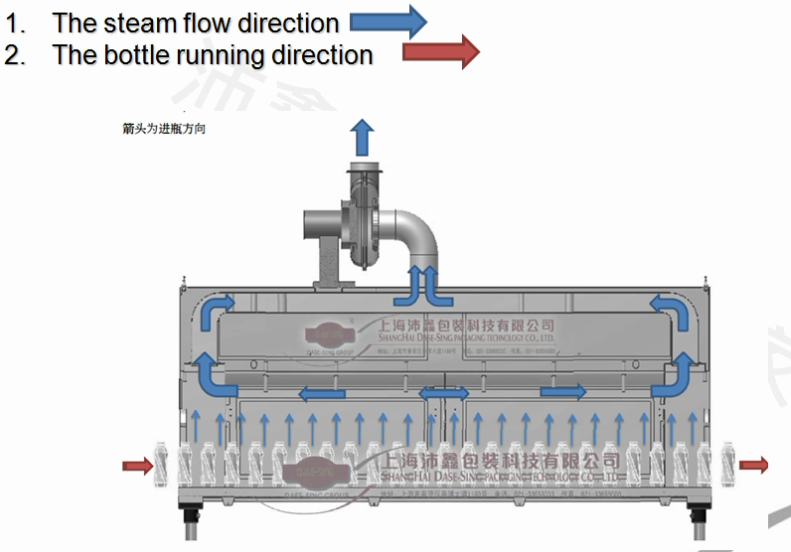
Using steam to shrink labels on bottles requires careful preparation and attention to detail. Here are the key steps to follow:
1. Preheat the steam tunnel: Before starting the labeling process, preheat the steam tunnel to the recommended temperature for the specific shrink sleeve label material. Dase-Sing desins unique option for system to detect temperature to avoid defect shrinkage in tunnel.
2. Prepare the bottles: Make sure the bottles are clean and free from any dust or debris. This will ensure proper adhesion of the shrink sleeve label.
3. Position the steam nozzle: Adjust the position of the steam nozzle to ensure that the steam is evenly distributed across the entire label surface. This will help achieve uniform shrinkage.
4. Check the bottles from sleeve machine: label position must be all the same and at request position.
5. Activate the conveyor: Turn on the conveyor motor to supply bottle to tunnel and allow the bottles to be exposed to the steam for the recommended amount of time. This will activate the shrink sleeve label and initiate the shrinking process.
6. Monitor the shrinkage: Keep a close eye on the shrinkage process to ensure that the labels are shrinking uniformly and without any defects. Adjust the steam pressure or nozzle position if necessary. If the shrinkage is not good, go back to step 2.
7. Remove the bottles from the steam tunnel: Once label shrinkage is complete , carefully remove the bottles from the conveyor.
By following these steps, manufacturers can effectively use steam to shrink labels on bottles and achieve perfect bottle body label shrinkage.
The position of the steam nozzle plays a crucial role in achieving optimal shrinkage of the sleeve labels. Here are some tips for adjusting the position of the steam nozzle:
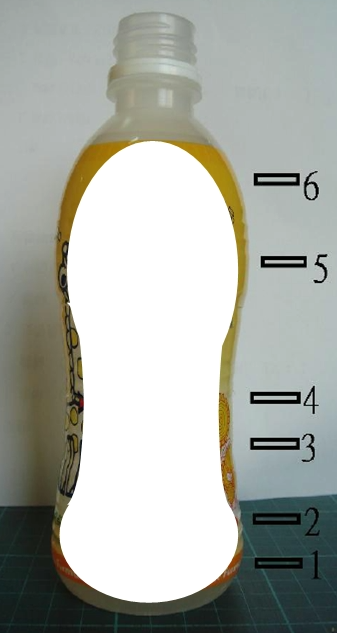 As above picture, for curve shape bottle, the full body label shrinkage tips is to fix label at bottle bottom and then step by step to shrink label to top. So the nozzle position in tunnel is at position at 1 -> 2 -> 3 -> 4 -> 5 -> 6 (as below). Nozzle adjustment depends in bottle and label outline. (If the noozles are not 6 pairs, modifies the 1~6 positions to 1~4 positions according to bottle height.)
As above picture, for curve shape bottle, the full body label shrinkage tips is to fix label at bottle bottom and then step by step to shrink label to top. So the nozzle position in tunnel is at position at 1 -> 2 -> 3 -> 4 -> 5 -> 6 (as below). Nozzle adjustment depends in bottle and label outline. (If the noozles are not 6 pairs, modifies the 1~6 positions to 1~4 positions according to bottle height.)
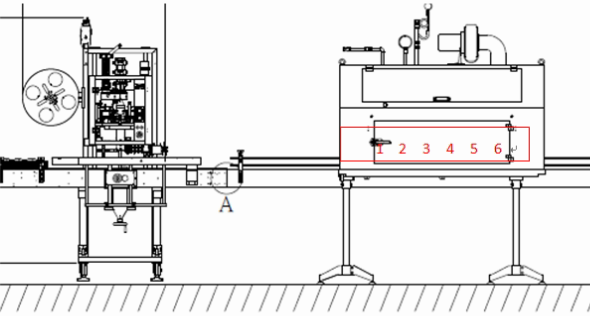
1. Proper alignment: Make sure the steam nozzle is aligned with the target area of the label. This will help distribute the steam evenly across the entire label surface.
2. Distance from the bottle: Adjust the distance between the steam nozzle and the bottle to ensure that the steam is focused on the label and not scattered. The ideal distance may vary depending on the specific shrink sleeve label material and bottle shape.
3. Position of the steam nozzle: Position the steam nozzle at a slight angle towards the bottle. This will help direct the steam towards the target area of the label and ensure uniform heat distribution.
4. Test and adjust: Conduct test runs with different steam nozzle positions to determine the optimal position for achieving perfect shrinkage. Observe the shrinkage process and make adjustments as needed or replace different nozzle types according to needs.
By following these tips, manufacturers can fine-tune the position of the steam nozzle and achieve optimal shrinkage of the sleeve labels on bottles.
Achieving perfect shrinkage of the sleeve labels requires following best practices for shrink sleeve application. Here are some key tips to ensure optimal results:
1. Proper surface preparation: Clean the bottle surface thoroughly to remove any dirt, oil, or residue. This will ensure proper adhesion of the shrink sleeve label.
2. Correct label sizing: Choose shrink sleeve labels that are properly sized for the bottle. The label should have a slight overlap to ensure complete coverage and avoid any gaps.
3. Optimal steam flow rate and pressure: Follow the guidelines for the recommended steamflow rate and pressure settings. Improper settings can result in incomplete shrinkage or damage to the label.
4. Even heat distribution: Ensure that the steam is evenly distributed across the entire label surface. This can be achieved by adjusting the steam nozzle position and maintaining a consistent steam supply.
5. Setting control inspections: Mark and record the nozzle valve opening position for different bottles/labels. It will help to change bottles/labels efficiently.
6. Proper steam exhaust:The steam exhaust should ensure enough low temerature steam to be vented out. It will help refill in tunnel shrink section with high temperature steam.
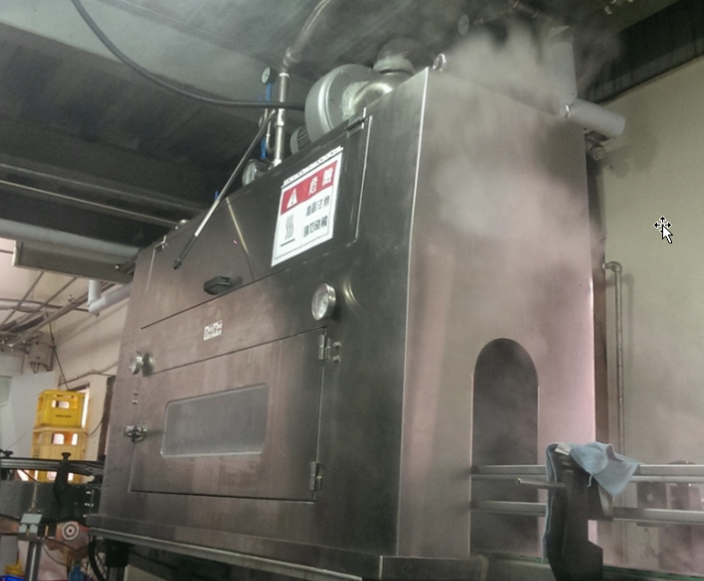
As figure above, the steam exhaust is not good
By following these best practices, manufacturers can ensure perfect shrinkage of the sleeve labels and achieve a professional and visually appealing finished product.
Dase-Sing customer service team accumulated over 30 years' experience and can support customers fast and throughly. If you need more information about real practice, welcome to contact us.
More video:
https://www.youtube.com/@dase-singpackagingtechnolo8451
Constct us:
matt@dasesing.com